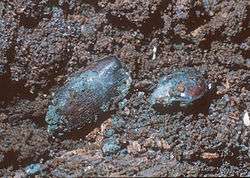Metarhizium majus
| Metarhizium majus | |
|---|---|
 | |
| Remains of Oryctes rhinoceros adult infected with M. majus: Dipolog, Mindanao, Philippines (1977) | |
| Scientific classification | |
| Kingdom: | Fungi |
| Division: | Ascomycota |
| Class: | Sordariomycetes |
| Order: | Hypocreales |
| Family: | Clavicipitaceae |
| Genus: | Metarhizium |
| Species: | M. majus |
| Binomial name | |
| Metarhizium majus (J.R.Johnst.) J.F.Bisch., Rehner & Humber (2009) | |
Metarhizium majus[1] is the new name given to a group of fungal isolates that are known to be virulent against Scarabaeidae, a family of beetles. Previously, this species has had variety status in Metarhizium anisopliae (var. majus) and its name is derived from characteristically very large spores (typically 2.5–4 µm x 10–14 µm long) for the genus Metarhizium. There has been considerable interest in developing isolates of this species into mycoinsecticides: especially for coconut and oil palm beetle pests in SE Asia, the Pacific region and Africa.
It is an anamorph, its telomorphic form is Cordyceps brittlebankisoides.[2]
Important Isolates
- The epitype is isolate ARSEF 1914: derived from a dried US National Fungus Collection culture (BPI 878297)[1].
References
- ↑ Bischoff J.F., Rehner S.A. and Humber R.A. (2009). "A multilocus phylogeny of the Metarhizium anisopliae lineage". Mycologia. 101 (4): 512–530. doi:10.3852/07-202. PMID 19623931.
- ↑ Liu, Z.; et al. (2002). "Molecular evidence for teleomorph-anamorph connections in Cordyceps based on ITS-5.8S rDNA sequences". Mycological Research. 106 (9): 1100–1108. doi:10.1017/S0953756202006378.
See also
This article is issued from Wikipedia - version of the 10/3/2015. The text is available under the Creative Commons Attribution/Share Alike but additional terms may apply for the media files.